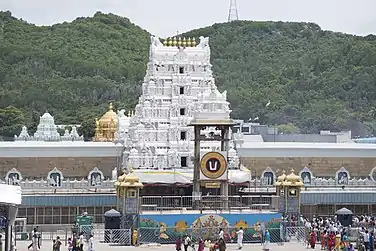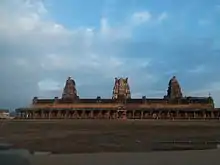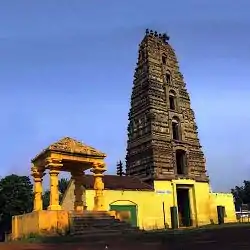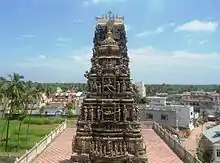Chintalarayaswami Temple
Chintalarayaswamy Temple or Sri Chintala Venkataramana Temple is a Hindu Vaishnavite temple situated at Tadipatri, a town in the Anantapur District of Andhra Pradesh, India.[1] The Temple is dedicated to Lord Venkateswara, a form of Vishnu, who is referred to as Chintala Venkataramana.[2] The temple was built by Pemmasani Timmanayudu II of the Pemmasani Nayaks. It is situated on the bank of the Penna River, which passes through the town.[1] The temple is known for its granite sculptures and is classified as one of the Monuments of National Importance by Archaeological Survey of India (ASI). The temple has a Garuda Mandapa built as chariot with rotating granite wheels, which is similar to the one found in the Vithala Temple of Hampi.

Etymology
According to legend, it is believed that, the presiding deity Venkateswara was found in the Tamarind (Telugu: Chinta) tree and hence got the name Chintala Venkataramana.[2]
History
The Temple was built during reign of Vijayanagara empire in mid 16th Century.[3] Pemmasani Timmanayudu II, a contemporary of Vira Narasimharaya and Krishnadevaraya, built this temple.[4][5] Timmanayudu built this temple after Lord Vishnu is said to have told Timmanayudu in a dream that a temple should be constructed for him at Tadipatri.[6][7] Timmanayudu appointed two archakas and a chief-priest, and he gifted lands to the temple.[8] The Chintalarayaswamy Temple is considered as one of the finest examples of Vijayanagara architecture.[8] The initial structure may belong to Saluva dynasty, but the entrance towers belongs to the Tuluva dynasty.[3]
Architecture
The temple was built in Dravidian style.[3]
Gallery
.jpg.webp) Chintalaraya Temple with Vimanams
Chintalaraya Temple with Vimanams A huge pillar with a person riding the Yali
A huge pillar with a person riding the Yali.jpg.webp) A wall with sculptures
A wall with sculptures Nartaka Mudra
Nartaka Mudra.jpg.webp) A idol depicting deity
A idol depicting deity Elephants
Elephants
See also
- Bugga Ramalingeswara Swamy temple
- Temples of Andhra Pradesh
References
- Poverty Alleviation Through Self-Help Groups in Anantapur District of Andhra Pradesh. Anchor Academic Publishing. 2017. ISBN 9783960671619.
- Guide to Monuments of India. Viking. 1989. ISBN 9780670806966.
- Architecture and Art of Southern India: Vijayanagara and the Successor States 1350-1750. Cambridge University Press. 1995. ISBN 9780521441100.
- Sriramamurty, Y. (1973), "The Pemmasani Family" (PDF), Studies in the History of the Telugu country during the Vijayanagara period 1336 to 1650 A D, Karnatak University/Shodhganga, p. 272, hdl:10603/107988
- Ramaswami, N.S (1975), Temples of Tadpatri, Govt. of Andhra Pradesh, p. 10–11
- Sriramurty 1973, p. 272
- Ramaswami 1975, pp. 10–11
- Sriramurty 1973, p. 273
| Wikimedia Commons has media related to Chintalarayaswami Temple. |




